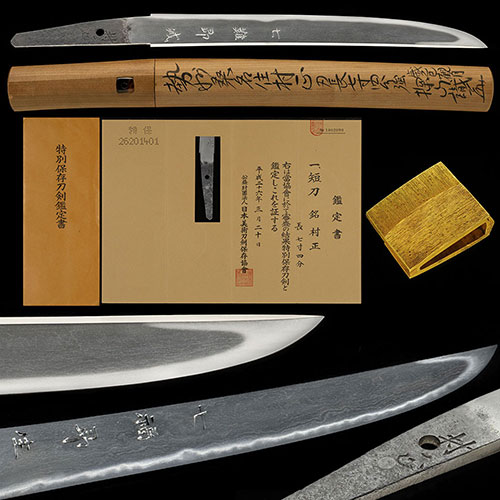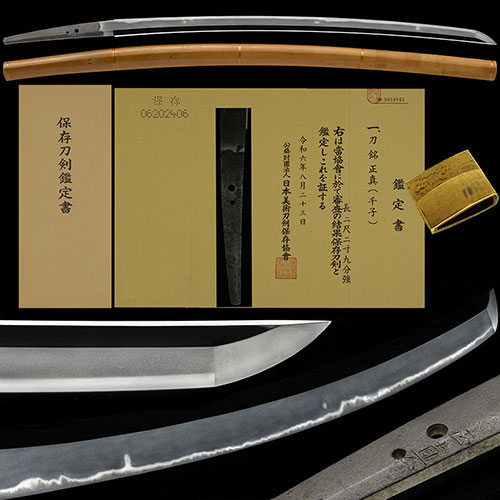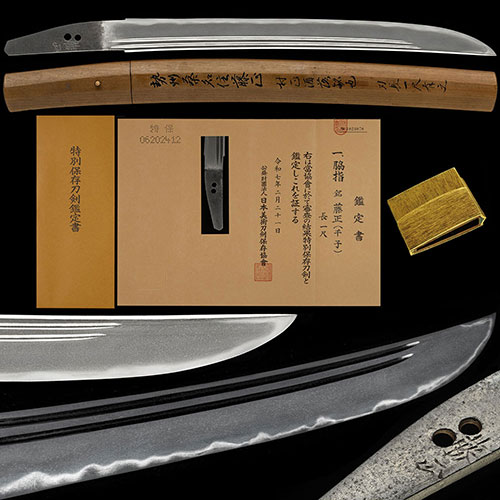
村正 短刀 Muramasa Tanto
No.124849短刀 村正 二代傑作短刀 重要候補 タナゴ腹茎 精良な地鉄に足葉入り金筋砂流し頻りに掛る 田野辺先生鞘書 金無垢ハバキ 七寸四分Tanto Muramasa, 2nd generation Masterpiece Tanto, Juyo candidate, Tanagobara-Nakago, clear Jigane, There are Ashi and You, Kinsuji and Sunagashi entered frequently, professor Tanobe Sayagaki, Kinmuku-Habaki 22.5cm
商談中Hold
関連商品
- 銘表Mei-Omote
- 村正村正 Muramasa
- 登録証Registration
- 島根県 Shimane 昭和26年5月8日 5/8/26(Showa)
- 時代Period
- 室町後期天文頃Late Muromachi period, around Tenbun period
- 法量Size
-
刃長 22.5cm ( 七寸四分) 反り 0.1cm
元幅 2.2cm 元重 0.50cm 茎長 9.3cm 重量 108gHachou 22.5cm ( 七寸四分) Sori 0.1cm
Moto-Haba 2.2cm Moto-Kasane 0.50cm Nakago-Chou 9.3cm Weight 108g - 国Country
- 伊勢Ise
- 姿Shape
- 平造、三ツ棟、僅かに反りつく。Hiradukuri, Mitsumune, Slightly Soritsuku.
- 鍛Kitae
- 板目肌つみ、流れ肌交り、地沸微塵に厚くつき、地景よく入り、映り立ち、鉄明るく冴える。Itamehada-tsumi, Mixed Nagarehada, Jinie entered fine and thick, Chikei entered finely, Utsuritachi, Iron is bright and clear.
- 刃文Hamon
- 浅くのたれて、小互の目交じり、足・葉入り、小沸つき、金筋・砂流し掛り、匂口明るい。Shallow Notare, Mixed Small-Gunome, There are Ashi and You, Small-Nie-tsuki, Kinsuji and Sunagashi-kakari, Nioikuchi is bright.
- 帽子Boushi
- 直ぐに小丸、先掃きかけて、深く返る。Suguni-Komaru, Sakihakikakete, Deep return(Fukaku-kaeru)
- 茎Nakago
- 生ぶ、先入山形、鑢目勝手下り、目釘孔二内一埋。Ubu, Sakiiriyamagata, Yasurimekattesagari, One of the two mekugi will be filled in.
- ハバキHabaki
- 金無垢二重。Double Kinmuku
- 彫物Carving
- 表に「七難即滅」裏に「七福即生」の法語を彫る。The Buddhist words "Instant Elimination of Seven Disasters" are engraved on the front and "Instant Birth of Seven Blessings" on the back.
- 説明Drscription
- 村正が徳川家に祟る刀といわれた所以について、徳川将軍家の公式記録である「徳川実紀」によると、家康の祖父松平清康が天文四年(1535年)に家臣に村正の刀で斬られた事に始まり、父広忠が乱心した家臣に村正の脇指で刺され、信長から内通の嫌疑をかけられ、切腹に追い込まれた家康の長男信康を介錯した刀も村正であり、また、家康自身も信長の甥長孝の戦功報告を受けた際に、村正の槍を検分中に手に怪我を負ったりと、凶事がいくつも重なったとあり、村正は徳川家に祟る妖刀として一般に広く認知されるようになった。初代村正は、美濃赤坂兼村或いは関兼春の門で、美濃から伊勢国桑名の地に移住したと伝わり、初代村正の現存する最も古い年紀が文亀元年(1501年)で、以後代の継承がみられ、天文頃の村正が二代、天正頃の村正を三代としている。この刀は、細身で小振りの品の良い短刀で、タナゴ腹茎に、二代の典型的は銘字を切り、地沸微塵に厚くつき、地景よく入り、映り立つ明るく冴え精良な地鉄に、浅くのたれて、小互の目交じり、足・葉頻りに入り、小沸深くつき、金筋砂流し頻りに掛り、匂口明るい最も上手な二代の傑作である。Regarding the reason why Muramasa was said to be a sword cursed by the Tokugawa family, according to the official record of the Tokugawa shogun family, ``Tokugawa Jikki'', Ieyasu's grandfather, Kiyoyasu Matsudaira, killed his vassals with Muramasa's sword in 1535. Muramasa was also the sword that helped Ieyasu's eldest son Nobuyasu, who was forced to commit seppuku after his father Hirotada was stabbed by Muramasa's armpit finger by a mad vassal, and who was suspected of being an insider by Nobunaga.
In addition, when Ieyasu himself received a report of his military exploits from Nobunaga's nephew Nagataka, he injured his hand while inspecting Muramasa's spear, and it is said that he suffered a series of misfortunes, and Muramasa cursed the Tokugawa family. It became widely recognized as a witch sword.
The first Muramasa is said to have moved from Mino to Kuwana, Ise Province, at the gate of Mino Akasaka Kanemura or Seki Kaneharu.The oldest surviving Muramasa 1st generation is in 1501, and it has been handed down from generation to generation.
This sword is a slender, small and elegant Tanto, with a typical Nidai signature carved into the Tanagobara-Nakago, Jinie entered fine and thick, Chikei entetred frequently, Utsuritatsu with clear bright good Jigane, Shallow Notare, Mixed Small-Gunome, There are Ashi and You frequently, Small-Nie entered deeply, Kinsuji and Sunagashi entered frequently, Nioikuchi is bright, making it a masterpiece of Nidia's finest work.




